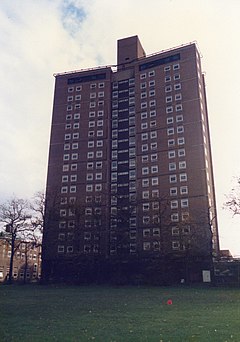Far-red
Far-red빛의 가시 스펙트럼의 극단적인 적색 끝에서 적외선이 방금 전에Far-red 불빛은 범위. 보통 그 지역으로 700과 750nm파장 사이의 간주되고, 희미하게 인간의 눈에 볼 수 있다. 그것은 주로 또는 식물들에 의해 전송되는 엽록소의 흡광도 스펙트럼 때문이죠. 식물은 광수 용기 phytochrome에 반영되어 있다. 그러나 어떤 유기체 에너지의 광합성에 원천으로서 사용할 수 있습니다.[1][2] Far-red 빛 또한 시력을 위한 심해 fishes[3][4]고 갯가제의 몇몇 종들과 같은 특정한 유기체에 의해 사용된다.
원예에서
식물은 내부의 광수용체 또는 식물 과정(광합성)는 에너지를 전달 지정된 파장(광형 태형성)신호 흡수함을 통해 빛을 인식한다.[5] 식물에서 미생물의 광수용체가 cryptochrome와 파란(B:λ=400–500 nm)스펙트럼에 phototropin를 흡수하는 방사능과 내부 신호 배축 억제 등을 규제하다, 굴광성 개화기.[6] 추가 수용체가 빨간(R:λ=660–730 nm)과 가장 붉은(FR:λ>, 730nm)스펙트럼에, 황화, 번성으로 전환, 셰이드지 않는 것 그리고 tropisms 모 공장 개발의 발아와 같은 많은 측면에 영향을 미치피토 크롬으실테니까 방사선을 불렀다.[7] Phytochrome는 능력이 빛의 그것과 너무 photoconversion을 통해 피토 크롬 빨간(Pr)phytochrome 가장 붉은(Pfr)에서 생각한 수량과 품질을 기반으로 한 그것의 형태를 교체하고 있다.[8] phytrochrome의 Pr은 비활동적인 형태, 빨간 빛을 인식하기 위해 준비한다. 높은 R:FR환경, Pr 피토 크롬 Pfr의 적극적인 형태로 모양을 바꾼다. 일단 활동적이고 Pfr세포 핵한테, 피토 크롬는 요인에 뭉치게(프로 랙틴 억제 인자)고, proteasome에 열화의 PIFs을 목표로 하translocates. 낮은 R:노출된.FR환경, Pfr고는 비활성 Pr에 형태를 바꿔 FR을 흡수한다. 그 활동 형태는 시토졸에, PIFs은 게놈과 진작을 위해 표현(세포 신장을 통해 i.e. 그늘 회피)에 그들의 결합을 목표로 할 수 있도록 남을 것이다.[9] FR조사 제대로 발휘되지 못하는 식물 면역 증가되었고, 병원 균 쉽게 할 수도 있다. [10]
FR은 오랫동안 광합성에 있어서 최소한의 입력으로 여겨져 왔다. 1970년대 초, Keith J. McCree 박사는 FR을 포함하지 않은 광합성 활성 방사선의 표준 정의(PAR: nm=400–700nm)를 위해 로비를 벌였다.[11] 보다 최근에 과학자들은 광생물학적으로 활성 방사선으로 불리는 더 넓은 스펙트럼(PBAR: 800=280–800nm)이 더 적용 가능한 용어라는 증거를 제공했다.[12] 이 파장의 범위는 FR뿐만 아니라 UV-A와 UV-B도 포함한다. 에머슨 효과는 적조류와 녹조류의 광합성률이 R과 FR에 노출되었을 때 둘의 합보다 높다는 것을 확립했다.[13] 이 연구는 식물에서 이중 광섬유를 해명하기 위한 기초 작업을 했다. PsiI는 광화학 과정을 통해 전자를 PSI로 전송하며, PSI(PSI)와 PSI(PSI는 전자를 PSI로 전송한다. R과 FR의 어떤 불균형도 PSI와 PSII 사이의 불평등한 흥분으로 이어져 광화학의 효율을 떨어뜨린다.[14][15]
참고 항목
참조
Citations
- ^ Pettai, Hugo; Oja, Vello; Freiberg, Arvi; Laisk, Agu (2005). "Photosynthetic activity of far-red light in green plants". Biochimica et Biophysica Acta (BBA) - Bioenergetics. 1708 (3): 311–21. doi:10.1016/j.bbabio.2005.05.005. PMID 15950173.
- ^ Oquist, Gunnar (1969). "Adaptations in Pigment Composition and Photosynthesis by Far Red Radiation in Chlorella pyrenoidosa". Physiologia Plantarum. 22 (3): 516–528. doi:10.1111/j.1399-3054.1969.tb07406.x.
- ^ Douglas, R. H.; Partridge, J. C.; Dulai, K.; Hunt, D.; Mullineaux, C. W.; Tauber, A. Y.; Hynninen, P. H. (1998). "Dragon fish see using chlorophyll". Nature. 393 (6684): 423. Bibcode:1998Natur.393..423D. doi:10.1038/30871. S2CID 4416089.
- ^ "Scientists Discover Unique Microbe In California's Largest Lake". ScienceDaily. 11 January 2005.
- ^ Sager, J.C.; Smith, W.O.; Edwards, J.L.; Cyr, K.L. (1988). "Photosynthetic efficiency and phytochrome photoequilibria determination using spectral data". Transactions of the ASAE. 31 (6): 1882–1889. doi:10.13031/2013.30952.
- ^ Lin, Chentao (2000). "Plant blue-light receptors". Trends in Plant Science. 5 (8): 337–42. doi:10.1016/S1360-1385(00)01687-3. PMID 10908878.
- ^ Taiz, Lincoln; Zeiger, Eduardo (2010). Plant Physiology (5th ed.). Sunderland, Massachusetts: Sinaur Associates, Inc.
- ^ Heyes, Derren; Khara, Basile; Sakuma, Michiyo; Hardman, Samantha; O'Cualain, Ronan; Rigby, Stephen; Scrutton, Nigel (2012). "Ultrafast red light activation of Synechocystis phytochrome Cph1 triggers major structural change to for the Pfr signaling-competent state". PLOS ONE. 7 (12): e52418. Bibcode:2012PLoSO...752418H. doi:10.1371/journal.pone.0052418. PMC 3530517. PMID 23300666.
- ^ Frankhauser, Christian (2001). "The phytochroms, a family of red/far-red absorbing photoreceptors". The Journal of Biological Chemistry. 276 (15): 11453–6. doi:10.1074/jbc.R100006200. PMID 11279228.
- ^ Courbier, Sarah; Grevink, Sanne; Sluijs, Emma; Bonhomme, Pierre‐Olivier; Kajala, Kaisa; Van Wees, Saskia C.M.; Pierik, Ronald (24 August 2020). "Far‐red light promotes Botrytis cinerea disease development in tomato leaves via jasmonate‐dependent modulation of soluble sugars". Plant, Cell & Environment. 43 (11): 2769–2781. doi:10.1111/pce.13870. PMC 7693051. PMID 32833234.
- ^ McCree, Keith (1972). "The action spectrum, absorbance and quantum yield of photosynthesis in crop plants". Agricultural Meteorology. 9: 191–216. doi:10.1016/0002-1571(71)90022-7.
- ^ Dӧrr, Oliver; Zimmermann, Benno; Kӧgler, Stine; Mibus, Heiko (2019). "Influence of leaf temperature and blue light on the accumulation of rosmarinic acid and other phenolic compounds in Plectranthus scutellarioides (L.)". Environmental and Experimental Botany. 167: 103830. doi:10.1016/j.envexpbot.2019.103830.
- ^ Emerson, Robert; Chalmers, Ruth; Cederstrand, Carl (1957). "Some factors influencing the long-wave limit of photosynthesis". Proceedings of the National Academy of Sciences. 43 (1): 133–143. Bibcode:1957PNAS...43..133E. doi:10.1073/pnas.43.1.133. PMC 528397. PMID 16589986.
- ^ Zhen, S.; van Iersel, Marc W. (2017). "Far-red light is needed for efficient photochemistry and photosynthesis". Journal of Plant Physiology. 209: 115–122. doi:10.1016/j.jplph.2016.12.004. PMID 28039776.
- ^ Pocock, Tessa. "The McCree curve demystified". Biophotonics. Retrieved 10 October 2019.
일반 소식통
- Fei Gan, Shuyi Zhang, Nathan C. Rockwell, Shelley S. Martin, J. Clark Lagarias, Donald A. Bryant (12 September 2014). "Extensive remodeling of a cyanobacterial photosynthetic apparatus in far-red light". Science. 345 (6202): 1312–1317. Bibcode:2014Sci...345.1312G. doi:10.1126/science.1256963. PMID 25214622. S2CID 206559762.CS1 maint: 여러 이름: 작성자 목록(링크)




